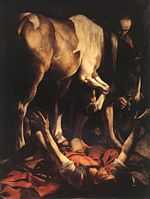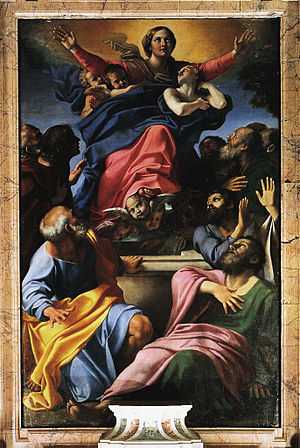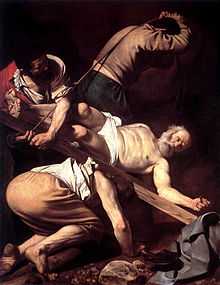Cerasi Chapel
The Cerasi Chapel (Italian: Cappella Cerasi) is one of side chapels in the transept of the Church of Santa Maria del Popolo in Rome. It contains significant paintings by Michelangelo Merisi da Caravaggio and Annibale Carracci, two of the most important masters of Baroque art, dating from 1600-1601.
History
The chapel, which was founded by Cardinal Pietro Foscari, was purchased in 8 July 1600 by Monsignor Tiberio Cerasi, Consistorial Advocate and Treasurer-General to Pope Clement VIII.[1] He bought it from the Augustinian friars with the option to rebuild and adorn it "in the manner and form" he had wanted to. The chapel was remodelled by Carlo Maderno.
In September Cerasi commissioned Carracci and Caravaggio, the two leading emerging artists of the day, to provide an altarpiece of The Assumption of Mary (Carracci) and The Conversion of Saint Paul on the Road to Damascus and The Crucifixion of Saint Peter (Caravaggio) for the two side walls. Cerasi's choice of the Assumption for the altar seems straightforward enough, while the Saint Paul and Saint Peter honoured the two Apostles central to the Catholic Church, as well as the popular Counter-Reformation themes of conversion and martydom. The precedent already existed for this juxtaposition in the Cappella Paolina at the Vatican by Michelangelo.[2] The first versions of the Caravaggio paintings were rejected by the patron.
Cerasi died on 3 May 1601. In his will he named the Hospital of the Madonna della Consolazione as his heir with the responsibility to complete the unfinished chapel. At the time the Caravaggio paintings were already placed in the chapel.[3]
The chapel was restored in the middle and the end of the 19th century by Antonio Cerasi.
Description
The oblong shaped chapel consists of a sail-vaulted anteroom and a narrower, barrel-vaulted chancel with the altar whivh is lit by a lunette window on the back wall. The arched entrance is screened by a colourful marble balustrade. The focus of the architecture is the altar shaped as an aedicule of black and white marble with two Corinthian columns and a broken pediment.
Caravaggio's dramatically lit and foreshortened paintings are intended to be viewed from the side rather than straight-on, and draw the eye to Carracci's frontally presented Assumption, so that the chapel is aesthetically united despite the very different styles of the two artists. According to Steinberg the light on the Caravaggio paintings comes from the painted heaven on the vault of the anteroom, inhabited by the dove of the Holy Spirit.[4] On the other hand Varriano claims that the "source" of the light seems to be the clerestory window across the transept.[5]
The chapel is decorated in exuberant Baroque style. The frescos on the short barrel-vault of the chancel depict the Coronation of the Virgin (central medaillon) and the Visions of Sts Peter and Paul (side panels) set in rich gilded stucco frames. They were executed by Innocenzo Tacconi, an able assistant of Annibale Caracci, and at least the coronation scene was designed by Caracci himself. Iconographically the side panels "relate to the Caravaggio paintings in that they manifest the divine cause of what passes below" them. Similary the Coronation scene is placed above Caracci's Assumption as a direct continuation. The vault forms a celestial zone in close contact with the three famous paintings below.[4]
The frescos in the anteroom of the chapel are by Giovanni Battista Ricci da Novara, and depict the Holy Spirit and the Evangelists (on the vault and the spandrels) and the Doctors of the Church (in the lunettes).
There are tombs on the lateral walls of the anteroom, one for Tiberio Cerasi, the founder of the chapel on the left and another for his father, Stefano Cerasi (†1575) on the right (1601). These are typical Baroque funeral wall monuments with the carved busts of the deceised in ovals, curved broken pediments and epitaphs. The projecting heads are turned towards the altar.
Gallery
-

Conversion on the Way to Damascus (Caravaggio)
-

Assumption of the Virgin Mary (Caracci)
-

Crucifixion of St. Peter (Caravaggio)
-
The chapel from the transept
-
Frescos of Innocenzo Tacconi on the vault
-
Pavement
Notes
Bibliography
- Leo Steinberg: Observations in the Cerasi Chapel, in: The Art Bulletin, Vol. 41, No. 2 (Jun., 1959), pp. 183-190
- Lilian H. Zirpolo: The A to Z of Renaissance Art, Scarecrow Press, 2008
- John L. Varriano: Caravaggio: The Art of Realism, Penn State University Press, 2006
- Christopher L. C. E. Witcombe: Two "Avvisi", Caravaggio, and Giulio Mancini, in: Source: Notes in the History of Art, Vol. 12, No. 3 (Spring 1993), pp. 22-29
| Wikimedia Commons has media related to Santa Maria del Popolo (Rome). |


